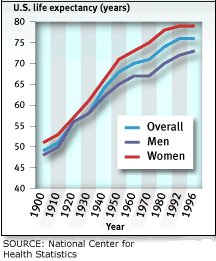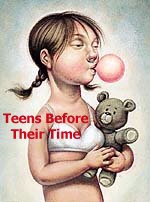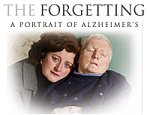BIOLOGY OF AGING
There are no diseases peculiar to old age and very few from
which it is exempt.
-Alfred Worcester (1855-1951)
 Twenty percent of all humans who have ever lived past the age of 65 are alive today.
And these older individuals are biologically younger than the old of generations
past: A landmark 1993 study by Duke University found that
the percentage of older Americans in good health is growing at a greater
rate than the percentage of those with disabilities.
Twenty percent of all humans who have ever lived past the age of 65 are alive today.
And these older individuals are biologically younger than the old of generations
past: A landmark 1993 study by Duke University found that
the percentage of older Americans in good health is growing at a greater
rate than the percentage of those with disabilities.
Between 1960 and 1990, while the overall U.S. population grew 39%,
the ranks of those 85 and older jumped 232% (the over 65 group increasing 89% while the
number of those under 25 grew by only 13%). A child born today who lives
to age 65 is ten times more likely to reach 100 than people born one century
ago (click here to see life expectancies at age
65 from 1910 on). Now in the year 2000, there are an estimated 100,000 people aged
100+, up from 32,000 in 1990. This should keep Willard Scott busy!
THE QUEST FOR LONGEVITY (IF NOT IMMORTALITY)
The news
was good in the September 1997 press release from the Centers for Disease
Control and Prevention. Life expectancy of Americans reached an all-time
high in 1996 of 76.1, indicating a continuing gain in the battle against
premature death. Click
here for Census report showing changes in life-expectancy of 65-year-olds
over the twentieth century (pdf format).
The quest for immortality seems to be an obsession of the human primate--its methodologies
dating back to some of the earliest recorded messages of the past. The search for long (if not everlasting) life is implicit within
Western mythology and within its scientific quests, as in:

-
the antediluvian beliefs that people lived longer in some past
Golden Age. Recall the supercentenarians in Genesis: Methuselah
supposedly lived to a ripe 969 (5:27), Jared 962 (5:20), Noah 950 (9:29), and Adam
930 (5:5).
-
the hyperborean beliefs that there are remote pockets of super
longevity around the world, pristine places without the stresses and pollution
of modern urban societies, where the old retain valued social roles. In
the 1970s, for instance, the press carried stories of people living to
extraordinary ages in Vilcabamba, high in the Andes of Ecuador, and in
the Azerbaijan republic of the former USSR. In 1973, for instance, Soviet
authorities reported the death of Azerbaijanian Shirali Mislimov, who supposedly
lived to 168, who was from a republic where there were 63 centenarians
per 100,000 population (compared to 3 in the United States).
-
the fountain of youth myths, where some wondrous substance or
procedure would extend life, such as young Achilles being dipped in the
pool of immortality by his mother. Such long-lived personalities as Pope
Pius XII, Bernard Baruch, and Somerset Maugham had the cells of unborn
lambs injected into their veins.
Enthusiasms were tempered with Leonard Hayflick's discovery of the finite
divisions of human cells, the so-called Hayflick
Limit--that, at least at the cellular level, we are somehow programmed to
die. After all, if Darwin's mechanisms of natural selection are to work,
old generations must be superceded by the new. But there flickered hope in
the cancer cells of Henrietta
Lacks which, one-half century after whose host's death, live eternally on
throughout the world. Could the death gene(s) be turned off? Enter telomerase
and its ability to lengthen the biological clock. Listen to NPR's
"Talk of the Nation's" "Merchants
of Immortality" (aired June 4, 2003) featuring an interview with
Stephen Hall, author of Merchants of Immortality: Chasing the Dream of Human
Life Extension.
-
The Buck Institute:"Advancing Age Research"
-
International Longevity Center--USA "An Institute for Research and Policy
on Aging"
-
Pamela McCorduck's "The Long and Winding Road: What happens when Gens X and Y ponder a 100-year lifespan? (American Demographics May 2000)

THINKING ABOUT THE INTERACTIONS BETWEEN
BIOLOGICAL,
PSYCHOLOGICAL, AND SOCIAL PROCESSES
Being a sociologist, I will leave it to the hypertexted links below
to more fully develop the biological
theories of aging (for layperson's overview, see U.S. News's
"What causes
aging? Wear and tear, or a molecular time bomb?"). Here, however, let's
consider the ways in which biological processes can be affected by socio-cultural
dynamics. Sample topics:
-
how rates of alcoholism, heart disease and mental disorders increase
with economic downturns.
-
how cancer rates increase with level of industrialization.
-
how depression is related to physical ailments. Eleanor Simonsick (Psychosomatic
Medicine, 1995) found that depression among men and women 65 and older
nearly triples their risk of stroke.
-
how poverty impacts health. Samuel Broder, director of the National
Cancer Institute in 1991, observed how people living below the federal
poverty level have a death rate from cancer twice that of the rest of the
population. Black men, who outnumber whites in poverty 3-to-1, were found
to have a 25 percent higher cancer risk.
-
how solitude can be lethal. According to a study by Nan Case et al.
(Journal of the American Medical Association, January 22, 1992),
heart attack victims who live alone are nearly twice as likely to die within
six months as those living with someone else. One hypothesis holds that
human contact produces protective hormones.
-
 recent stories of 60-something women giving birth bring to mind James
Tanner's studies of the historical changes in female sexual maturation.
Apparently over the past century and a half the age at menarche has declined
by three-quarters of a month per decade. Data indicates, for instance,
that the average Norwegian girl began menstruating at 17 in the 1840s,
compared to 12.9 years by the mid-1980s. And then there were the mid-1980s
stories of accelerated sexual growth from Puerto Rico, of girls ovulating
as young as 9 months and young boys still in diapers sprouting hair under
their arms.
recent stories of 60-something women giving birth bring to mind James
Tanner's studies of the historical changes in female sexual maturation.
Apparently over the past century and a half the age at menarche has declined
by three-quarters of a month per decade. Data indicates, for instance,
that the average Norwegian girl began menstruating at 17 in the 1840s,
compared to 12.9 years by the mid-1980s. And then there were the mid-1980s
stories of accelerated sexual growth from Puerto Rico, of girls ovulating
as young as 9 months and young boys still in diapers sprouting hair under
their arms.
-
how cohorts differ in their rates of Alzheimers, brain and lung cancers,
and deafness. Here consider the concept of cohort scars, those distinctive
biological maladies experienced by particular cohorts in old age owing
to the intersection of their biographies with social history. For instance,
in VA hospitals we still see the long term effects of mustard gas exposures
of World War I veterans. In 1983, physicians and statisticians estimated
that, owing to medical advances, the number of infants born with some physical
or mental disorder had doubled in the previous quarter century. What will
be the quality of the lives of these individuals in old age?
|
"Do you think you look older
than your years, or younger than your years, or do you look about your
age?"
| Do you think you look ... than your
years? |
MEN |
WOMEN |
| |
60-69 |
70+ |
60-69 |
70+ |
| OLDER |
3% |
4% |
6% |
4% |
| YOUNGER |
59% |
70% |
61% |
67% |
| ABOUT MY AGE |
37% |
25% |
30% |
26% |
| DON'T KNOW |
1% |
1% |
3% |
3% |
Source: Los Angeles Times 1999 national
survey, Study
#431, n=1590 |
Part of having a social purpose is having social responsibilities, and
this has profound biological implications. Consider the findings below
of Albert Bhak ("Social Integration Patterns and Senile Mortality," presented
at the 1975 annual meetings of the American Sociological Association, San
Francisco), who studied the monthly mortality rates for elderly men and
women in three small South Korean villages. The data show the patterns
of deaths of older persons, activity demands, climate, and food supply
over one calendar year.
|
DEATHS |
|
ACTIVITY DEMANDS |
|
|
| MONTH |
MALE |
FEMALE |
TOTAL |
|
MALE |
FEMALE |
FOOD
SUPPLY |
CLIMATE |
| JAN |
27 |
19 |
46 |
|
heavy |
heavy |
plentiful |
harshest |
| FEB |
32 |
26 |
58 |
|
nil |
moderate |
adequate |
harsh |
| MAR |
24 |
40 |
64 |
|
nil |
nil |
mild |
low |
| APR |
29 |
46 |
75 |
|
slight |
nil |
lowest |
great! |
| MAY |
29 |
32 |
61 |
|
moderate |
slight |
lowest |
mild |
| JUN |
16 |
14 |
30 |
|
heavy |
prime |
dwindling |
unpleasant |
| JUL |
21 |
18 |
39 |
|
prime |
prime |
adequate |
harsh |
| AUG |
33 |
19 |
52 |
|
slight |
slight |
low |
harshest |
| SEP |
18 |
14 |
32 |
|
heavy |
heavy |
dwindling |
mild |
| OCT |
20 |
16 |
36 |
|
prime |
heavy |
adequate |
great! |
| NOV |
31 |
27 |
58 |
|
slight |
slight |
plentiful |
unpleasant |
| DEC |
48 |
20 |
68 |
|
nil |
heavy |
plentiful |
harsh |
Do you observe any patterns? Bhak performed some statistical analyses
and came up with the following correlations of older Korean mortality rates:
CORRELATES OF OLDER MALE AND FEMALE DEATHS
| # DEATHS x |
MALES |
FEMALES |
ACTIVITY
DEMANDS |
-.73 |
-.86 |
| CLIMATE |
.39 |
.05 |
FOOD
SUPPLY |
-.15 |
.20 |
What does this tell you? First, activity demands produce the strongest
correlation with the number of older persons' deaths--specifically, the greater
the monthly social responsibilities of older persons the lower their death rate
(and, conversely, the fewer the role demands the higher the death rate of older
persons). The harsher the climate
the more likely old men (not women--guess who must be indoors) die. And although
small, the sex difference in signs of the food supply-death correlations
is interesting. Guess who gets fed first.
Click here to see
-
In Andrew Scharlach and Barry Robinson's "Curricular Module on the Aging
Process" (Berkeley), see their sections on the physiology
of aging and sensory
changes

-
Ever wish to compare the world records of different age groups for the same athletic event? The place to
find such information is the
World Masters Athletics website
-
Elizabeth
L. Rogers's "Why do we age?"
-
NATIONAL INSTITUTE ON
AGING
-
The
Merck Manual of Geriatrics Comprehensive overview of the medical, social,
psychological, and ethical issues in eldercare
-
Novartis Foundation for Gerontological
Research
-
National Ageing Research
Institute (Australia)
-
The Aging Research Centre Includes
listings of scientists, laboratories and companies involved in aging research
-
from USC's Ageworks,
Changes with Aging
-
GeroNet: Health and Aging Resources for
Higher Education (UCLA)
-
Gerard F. Anderson
& Peter S. Hussey, "Health and Population
Aging: A Multinational Comparison"
-
Alliance for Aging Research--"the nation's leading non-profit organization dedicated to improving
the health and independence of Americans as they age through public and private funding of medical research and geriatric education"
-
Susan Voge's "Ask
NOAH About: Aging and Alzheimer's". For a first-hand journal detailing experiences
with the disease, see Mary's Place.

-
Diseases involved in
aging
-
Alzheimer's Association--from the national voluntary health
organization in Chicago. A rich resource is its
Diversity Toolbox.
-
Alzheimer Web Home
Page
-
The Life Extension
Foundation
-
The
Longevity Game!
-
Health and Retirement
Study

 Return
to Social Gerontology Index
Return
to Social Gerontology Index

 Twenty percent of all humans who have ever lived past the age of 65 are alive today.
And these older individuals are biologically younger than the old of generations
past: A landmark 1993 study by Duke University found that
the percentage of older Americans in good health is growing at a greater
rate than the percentage of those with disabilities.
Twenty percent of all humans who have ever lived past the age of 65 are alive today.
And these older individuals are biologically younger than the old of generations
past: A landmark 1993 study by Duke University found that
the percentage of older Americans in good health is growing at a greater
rate than the percentage of those with disabilities.


 recent stories of 60-something women giving birth bring to mind James
Tanner's studies of the historical changes in female sexual maturation.
Apparently over the past century and a half the age at menarche has declined
by three-quarters of a month per decade. Data indicates, for instance,
that the average Norwegian girl began menstruating at 17 in the 1840s,
compared to 12.9 years by the mid-1980s. And then there were the mid-1980s
stories of accelerated sexual growth from Puerto Rico, of girls ovulating
as young as 9 months and young boys still in diapers sprouting hair under
their arms.
recent stories of 60-something women giving birth bring to mind James
Tanner's studies of the historical changes in female sexual maturation.
Apparently over the past century and a half the age at menarche has declined
by three-quarters of a month per decade. Data indicates, for instance,
that the average Norwegian girl began menstruating at 17 in the 1840s,
compared to 12.9 years by the mid-1980s. And then there were the mid-1980s
stories of accelerated sexual growth from Puerto Rico, of girls ovulating
as young as 9 months and young boys still in diapers sprouting hair under
their arms. Return
to Social Gerontology Index
Return
to Social Gerontology Index